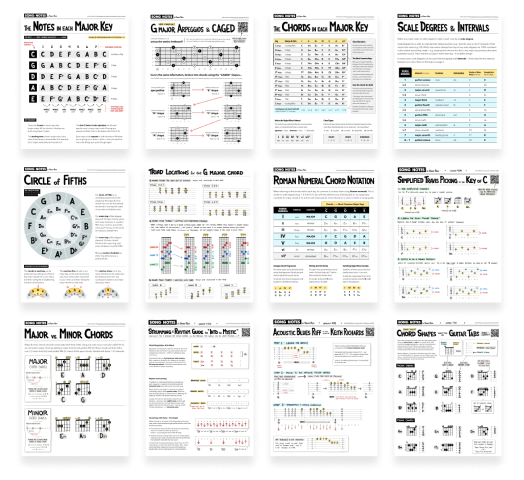Walking up & down between the E, A, and B7 (bass note transitions)
Lesson #49 • Feb 27, 2017
Instructional PDF 2 pages
Editor’s notes
In this lesson, I show a practice tip on how you can transition between the chords of E, A, and B7 – specifically by playing bass notes that walk up and down between these chords. This is a very common technique you’ll find in lots of country music, especially from artists like Johnny Cash (e.g., Walk the Line) and Willie Nelson (e.g., Angel Flying Too Close to the Ground). I’ll show you the basics of how to play the chords used (E, A, and B7 – including tabs) and then break down the fundamentals of this technique.
The core walk-ups and walk-downs of this lesson
In this lesson, I’ll show you how to walk up from E to A, from A to B7, and from B7 back down to A and E. In my video portion of the lesson, here’s the quick demo I play at the beginning where I preview this simple technique.
E ––––––0–––––0–––––0–––––––––––0–––––0–––––0––––––––|–
B ––––––0–––––0–––––0–––––––––––2–––––2–––––2––––––––|–
G ––––––1–––––1–––––1–––––––––––2–––––2–––––2––––––––|–
D ––––––2–––––2–––––2–––––––––––2–––––2–––––2––––––––|–
A ––––––2–––––2–––––2––––––––0––0––0––0––0––0––0––1––|–
E –––0––0––0––0––0––0––2––4––––––––––––––––––––––––––|–
E A
E –|––––2–––––2–––––2–––––––––––0–––––0––––0–––––––––||
B –|––––0–––––0–––––0–––––––––––0–––––0––––3–––––––––||
G –|––––2–––––2–––––2–––––––––––1–––––1––––1–––––––––||
D –|––––1–––––1–––––1–––––––––––2–––––2––––2–––––––––||
A –|–2––2––2––2––2––2–––––––––––2–––––2––––2–––––––––||
E –|–––––––––––––––––––4––2––0––0––0––0––––0–––––––––||
B7 E E7
For a very simple deconstruction of what’s going on here, refer to this tab. Note the bass notes between the chords! That’s what I want to focus on – these transitional bass notes.
E ––0–––––––––––0–––––––––––2––––––––0–––––––––––0––
B ––0–––––––––––2–––––––––––0––––––––2–––––––––––0––
G ––1–––––––––––2–––––––––––2––––––––2–––––––––––1––
D ––2–––––––––––2–––––––––––1––––––––2–––––––––––2––
A ––2–––––––––––0––0––1––2––2––2––1––0––0––––––––2––
E ––0––0––2––4–––––––––––––––––––––––––––––4––2––0––
E A B7 A E
Chords being used
By the way, if you need to worry about learning the chords I’m using here, refer to these tabs. In the right-hand version, I show a few barre chord voicings for the B-major chord (which I’m not using in this lesson, but wanted to include for reference & context).
E ––––0–––––––0––––––2––––– E –––––––––7––––
B ––––0–––––––2––––––0––––– B ––––4––––7––––
G ––––1–––––––2––––––2––––– G ––––4––––8––––
D ––––2–––––––2––––––1––––– D ––––4––––9––––
A ––––2–––––––0––––––2––––– A ––––2––––9––––
E ––––0–––––––––––––––––––– E –––––––––7––––
E A B7 B B
How to learn and practice this
If you’re just getting started with this run, first worry about E and A (don’t bring in B7 yet). Repeat this sequence, going from E to A and back down to E. Repeat.
E –––––0–––––0–––––0–––––––––––0–––––0–––––0––––––––
B –––––0–––––0–––––0–––––––––––2–––––2–––––2––––––––
G –––––1–––––1–––––1–––––––––––2–––––2–––––2––––––––
D –––––2–––––2–––––2–––––––––––2–––––2–––––2––––––––
A –––––2–––––2–––––2––––––––0––0––0––0––0––0––––––––
E ––0––0––0––0––0––0––2––4––––––––––––––––––––4––2––
E A
Then, worry about going from A to B7 and back to A. Repeat.
E –––––0–––––0–––––0–––––––––––2–––––2–––––2––––––––
B –––––2–––––2–––––2–––––––––––0–––––0–––––0––––––––
G –––––2–––––2–––––2–––––––––––2–––––2–––––2––––––––
D –––––2–––––2–––––2–––––––––––1–––––1–––––1––––––––
A ––0––0––0––0––0––0––0––1––2––2––2––2––2––2––2––1––
E ––––––––––––––––––––––––––––––––––––––––––––––––––
A B7
When you’ve mastered these two transitions, you can do the full E to A to B7 back down to A and E.
Having trouble with the middle and ring fingers?
When playing the bass notes, I strongly recommend using your middle and ring fingers (in addition to your index finger). While you technically can pull this off using only your index finger, it’s a bad habit that I suggest avoiding. You need to train your weaker fingers (middle, ring, pinky) – and though it can be frustrating at first it pays off later.
Here’s a simple exercise I suggest:
E –––––––––––––––––––––––––––––
B –––––––––––––––––––––––––––––
G ––––––––––––––––––––––––––––– 2nd fret = index finger
D ––––––––––––––––––––––––––––– ...repeat 3rd fret = middle finger
A ––––––––––––––––––––––––––––– 4th fret = ring finger
E –––2––3––4––3––2––3––4––3––––
Songs that use this sort of transition
“Walk the Line” by Johnny Cash is a powerhouse example of this technique used a ton. Here’s the first few measures. See my full lesson on this song if you want to learn it in full.
E –––––––––––0–––0––––––––––––2–––2––––––––––––0––––
B –––––––––––2–––2––––––––––––3–––3––––––––––––2––––
G –––––––––––2–––2––––––––––––2–––2––––––––––––2––––
D –––––––––––2–––2–––––––––0––––––––0–0––––––––2––––
A ––––––––0––––––––0–0–2–4––––––0–––––––4–2–0––0––––
E ––0–2–4––––––0––––––––––––––––––––––––––––––––––––
A D A
“Angel Flying Too Close to the Ground” by Willie Nelson has a similar run with these notes.
E –––0––––––––––––––––––––––––0––––
B –––0––––––––––––––––––––––––2––––
G –––1––––––––––––––––––––––––2––––
D –––2––––––––––––––––––––––––2––––
A –––2–––––––––––––––––––0––––0––––
E –––0–––0–––1–––2–––4–––––––––––––
E A
Enjoy my lessons? Buy me a beer!
If this and my other lessons have proven helpful to you, please consider making a one-time donation to my tip jar. Contributions of any amount help make this project possible (including the many, many hours I put into it).
Fun & Helpful Tools I've Made
Subscribe to my YouTube channel
Be sure to never miss a lesson by subscribing on YouTube. I put out 2-3 new videos every week. These include full song lessons, as well as covers, practice tips, behind-the-scenes updates. Thanks!
Recent Lessons
-
April 18, 2024
"Moonshadow" by Cat Stevens
-
April 9, 2024
Chords & Music Theory... 9 New Lessons!
-
March 30, 2024
Gordon Lightfoot's "Carefree Highway"
-
March 22, 2024
Lead Guitar & the F1 Theme Song
-
March 15, 2023
Pink Floyd's "Breathe" - with Simpler Chords Included
-
March 6, 2024
Q&A: 8 Tips to Avoid Muting Strings
-
March 1, 2024
Blues Shuffle Riffs - Using Just 2 Strings!
-
February 16, 2024
Soulful Lead Guitar with "America the Beautiful"
-
February 8, 2024
Country Honk by The Rolling Stones
-
January 31, 2024
Beginner Blues - New Course Sneak Peek!


